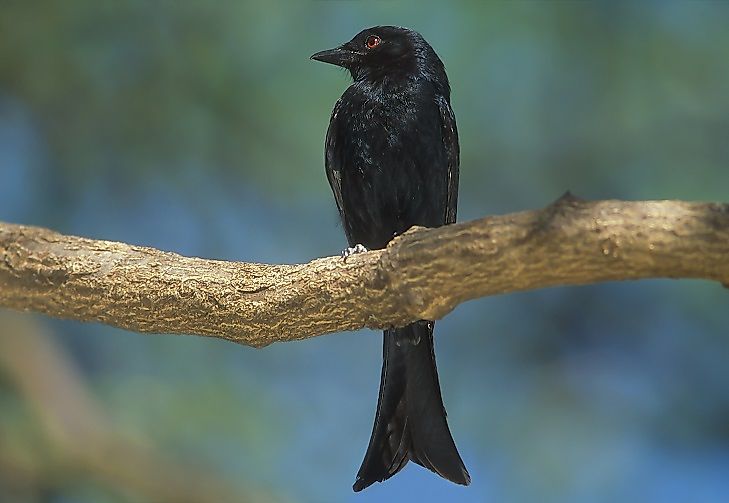Mauritania's Native Birds

Mauritania, officially known as the Islamic Republic of Mauritania, is located in the western region of North Africa. It is the eleventh largest country in Africa, and to the east and southeast borders Mali, the Atlantic Ocean to the west, Senegal to the southwest, and Algeria to the northeast, while Morocco and part of the Western Sahara lie to its north. The country’s area coverage is 397,685 square miles with a population of approximately 4.1 million. Nouakchott is the capital as well as the largest city in the country. Mauritania’s wildlife is comprised of both fauna as well as flora (plants).
Fork-Tailed Drongo
The Fork-Tailed Drongo, also called the Common, the African, or the Savanna Drongo, is scientifically known as Dicrurus adsimilis. It is a species of drongo from the family of Dicruridae and native to the tropics, subtropics, and temperate zones.it is mainly found in the sub-Saharan countries in on forests, bushes, and arid climates. The males are glossier on their backs than the females with an approximate length of up to 9.8 inches. Their diet is mainly made up of insect.
Sand Martin
The sand martin, scientifically known as the Riparia riparia, is a migratory passerine bird from the Family Hirundinidae. During summer, they are mainly found in Europe, northern Asia, Northern America and the Mediterranean countries whereas during winter are found in Eastern and Southern Africa, South America, and South Asia. The 4.7 inches long bird is found mainly near large bodies of water throughout the year. It lays approximately four to five eggs at a time and feeds mainly on insects like gnats and flies.
Greater Painted-Snipe
The greater painted- snipe, scientifically known as the Rostratula benghalensis, is a species of wader from the Family Rostratulidae. This species of wader’s exhibit sexual dimorphism where the females are larger and brightly colored than the males. They are found in the marshes along the shorelines, swamps, ponds, and streams in Africa, Nepal, India, Bangladesh, Pakistan, and South-east Asia. They are mainly found in groups varying from two to twelve, where the female lays eggs in a nest to be incubated by the males between the month of April and July. Their diet is composed of insects, crustaceans, mollusks as well as seeds.
Little Grebe
The little grebe, scientifically known as Tachybaptus ruficollis, is a water bird from the Family Podicipedidae. It is the smallest species of the grebe family with adult lengths ranging from 9.1 to 11.4 inches. The color of their feathers changes with the varying age as the adults are predominantly dark, especially in summer. The little grebe breeds in small colonies in densely vegetated areas, but after breeding, they migrate to more open and less vegetated areas. It is an excellent swimmer and divers in pursuit of the fish and other invertebrates which form a significant part of their diet.
Threats and Conservation Efforts
Habitat losses and global warming are the greatest challenges facing the birds of Mauritania. The Sand Martin Being is common species of bird, they are still in large numbers but over the years, habitat loss and fragmentation have led to the decrease in their numbers in states like California.
Mauritania's Native Birds
| Native Birds of Mauritania | Scientific Name |
|---|---|
| Fork-Tailed Drongo | Dicrurus adsimilis |
| Pied Avocet | Recurvirostra avosetta |
| African Yellow White-Eye | Zosterops senegalensis |
| Greater Painted-Snipe | Rostratula benghalensis |
| African Paradise Flycatcher | Terpsiphone viridis |
| Quail-Plover | Ortyxelos meiffrenii |
| Sand Martin | Riparia riparia |
| Greater Honeyguide | Indicator indicator |
| Brambling | Fringilla montifringilla |
| Little Grebe | Tachybaptus ruficollis |











